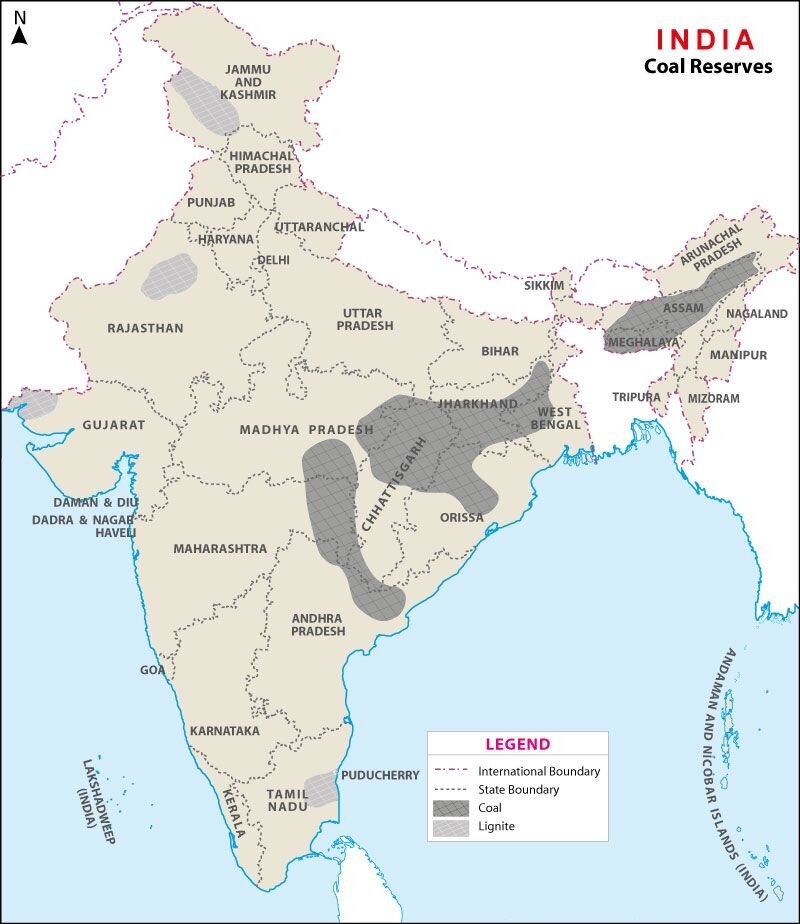Coal Sector Reforms | 19 Jun 2020
This article is based on “Unveiling reforms in India’s coal sector” which was published in The Hindustan Times on 17/06/2020. It talks about the intended benefits and challenges associated with the new set of coal reforms.
India, being a developing country, coal remains one of the most important indigenous energy resources and the dominant fuel for power generation and many industrial applications.
Presently, despite being the world's fourth-largest producer, India is the second-largest importer of the dry-fuel. Therefore, in line with the vision to build an ‘Atma Nirbhar Bharat’, a slew of reforms to promote commercial mining of coal in India, has been announced.
Unlocking coal mining for private players is a step forward to attain self-reliance in the coal sector. However, for sustainable utilization of coal, there is a need to look into these reforms from a multidimensional viewpoint.
Announced Reforms In Coal Sector
- Commercial mining of coal allowed, with 50 blocks to be offered to the private sector.
- Entry norms will be liberalised as it has done away with the regulation requiring power plants to use “washed” coal.
- Coal blocks to be offered to private companies on revenue sharing basis in place of fixed cost.
- Coal gasification/liquefaction to be incentivised through rebate in revenue share.
- Coal bed methane (CBM) extraction rights to be auctioned from Coal India’s coal mines.
Intended Benefits
Plugging Supply Gap: The nationalisation of coal in 1973 meant that domestic coal could be mined only by public sector companies.
- In this pursuit, Coal India Limited (CIL), registered an unprecedented increase in coal production and became the world's largest coal miner.
- However, the country’s coal demand continued to grow at a much faster rate. Due to this, the growth in coal import (2009 to 2014) stood at 23 per cent.
- Commercial mining of coal can increase the domestic production of coal and bridge the supply gap.
Boost Economy and Employment: Allowing commercial mining may help to address India’s coal production needs, provide investment opportunities and save precious foreign exchange.
- This will play a major role in ensuring the energy security of the country, as nearly the majority of power generation in India comes from thermal power plants.
- The domino effect on sectors that use coal, like steel, power and aluminium, is going to be significant.
Win-Win Situation: The government has introduced a more equitable system of sharing of revenues, moving away from fixed rates to a revenue-sharing model.
- Revenue sharing model will ensure when the prices go up, the miner shares more with the government; and if the price decreases, miner shares less. This is a win-win situation for both parties.
Associated Challenges
Dominance of Coal India: While reforms are aimed at ending the monopoly of Coal India Ltd., that’s unlikely to happen in the near future.
- The current commercial coal mining regime will find it difficult to compete with Coal India. As the major consumer of coal in India (thermal power plants and steel sector) are in long term purchase agreements with Coal India.
- Also, it will be a challenge for many companies to be able to match Coal India’s ability to navigate the complicated bureaucratic and political hurdles associated with opening new coal mines.
Issue with Non-washing of Coal: Doing away with the regulation requiring power plants to use “washed” coal will have huge environmental and economic costs.
- The “washing” requirement was introduced in 1997 and promised the use of cleaner coal in power production. It was India’s only legitimate justification to extend the use of coal as a development fuel despite the climate crisis.
- Also, a manufacturing or power-producing unit has to burn more coal and in turn generate not only ash but also noxious gases, particulate matter and carbon emissions.
Note:
- Coal washeries are units that reduce the ash content in coal through a mix of segregation, blending and washing techniques.
- These technologies are meant to allow the conservation and optimal use of coal reserves by improving the quality and efficiency of low grade, high ash Indian coal.
- Washed coal also provides high grade “coking” coal that is essential for the steel sector.
- Indian coal is known to contain 30-50% ash, meaning that for every two units of coal burned, one unit of ash could be produced.
External Challenges: In the era of intense competition from renewables, the rising NPAs of thermal power plants (TPPs) and a massive global withdrawal from fossil fuel for climate and environmental reasons poses a challenge of viability for commercialising coal.
Way Forward
- For easing commercialisation of coal, there is a need to establish a single-window clearance process for coal mines.
- Offering projects with secured clearances will boost timely development as well as increase industry participation
- Government support for the early resolution in land acquisition-related issues is needed to ensure timely operationalisation of coal mines.
- Further, commercial mining projects can be aided with investment in initial infrastructure settings which is more capital intensive than mining.
- Technology upgradation measures to be imposed to improve the productivity of the coal mines and improve recovery from the coal mines.
- The government may consider creating funds to support overseas acquisition to supplement domestic resources.
- Steps need to be taken to promote research and exploration activities and modern underground mass production technologies.
|
Drishti Mains Question “Coal remains one of the most important energy resources and the dominant fuel for power generation in India”. Analyze the need and challenges of commercial mining of coal in India. |
This editorial is based on “The Red Line” which was published in The Indian Express on June 18th, 2020. Now watch this on our Youtube channel.

